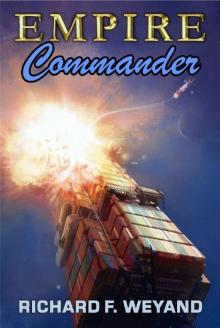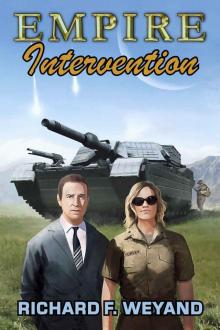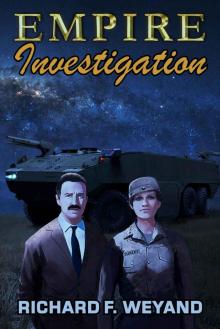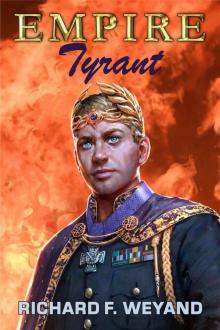- Home
- Richard F. Weyand
Commander Page 2
Commander Read online
Page 2
Willet looked at his notes for his next item.
“The crew accommodations should be copied from shipboard, Mr. Baum. No seaman gets his own cabin on ship. Enlisted men bunk together, three high, maybe six or twelve to a room. This whole building is easy four times the size it needs to be, maybe more. And get rid of the fuckin’ passenger elevators. It’s only three stories, fer crissake. Freight elevator, maybe. For big stuff. Put in ladders, too, no grand staircases.”
Willet looked at his notes again.
“Oh, yeah. I get bringin’ in food stores from outside the building, Mr. Baum. No sense havin’ separate stores if you’re on base. I agree with that, I guess. But we got our own galley and cooks. And the crew maintains its own spaces. That means cleanin’ up, washin’ dishes, moppin’ floors, doin’ laundry, stowin’ their own shit. No janitorial service, no maid service changin’ out linens, no chocolate bon-bon on your fuckin’ pillow with turn-down service.”
“But all those facilities and services are on base, Senior Chief. And we don’t need to limit the size of the building the way one does the volume of a warship.”
“You don’t get it, Mr. Baum. The crew of a warship is a community of disciplined and independent individuals workin’ together to achieve common goals. Where does that sense of community come from, where is that discipline learned, where is that independence fostered, when you got everybody holed up in his own room and you job out all the chores? You got rid of all the interaction and interdependence of the crew on each other, which is what builds the relationships and unit cohesion they rely on.
“Look. You can’t have a whole buncha guys lollin’ around in their rooms with their feet up, bein’ waited on hand and foot while they look out the fuckin’ windows, and then sound general quarters and have a warship crew show up like magic all of a sudden. If they’re gonna be a warship crew when you need ‘em to be, they have to be a warship crew all the time, from the time they come aboard until the time they leave the ship.
“Cram us in the can together, Mr. Baum. Like on ship. We got a thousand years o’ tradition and culture for how to make that work. You’re not goin’ to reinvent that in a month or two at the drawin’ board. Don’t make us try to fit our culture to your damn building. Design your damn building to fit our culture.”
Willet looked back down at his notes, then nodded.
“Anyway, that’s what I got,” he said.
He looked back up to see the head architect just staring at him.
“Hey, you don’t wanna hear the fuckin’ answer, don’t ask the fuckin’ question. Sir.”
The head architect looked helplessly to the senior officer present, Captain Fisher.
“Captain?”
“You heard the senior chief, Mr. Baum. I think you have some redesigning to do.”
Vendor Meeting
Fred Dunlop, the department head of ship acquisition for the Imperial Navy of the Sintaran Empire, was not looking forward to the vendor meeting he had called. All the ship manufacturers would have representatives there, and he would have to tell them none of their prototype plans were acceptable for purchase by the Navy.
It was not completely unexpected, which is why they had only been given six months to provide preliminary plans and cost estimates to his department. The idea had been to get their initial bad designs out of the way quickly. The proposal was so out of the realm of their prior experience Dunlop had expected they would take some time to get past their institutional myopia.
Warships were expensive. They were, for the most part, hand-built. Their offensive capability had to be crafted carefully in the context of the primary requirement to house, feed, and protect their crews.
Ships without crews were simply not part of their thinking.
“Ladies and gentlemen. If we can come to order, please.”
There were over two hundred people in the room, representing nearly a hundred different shipbuilding firms or their parts suppliers. The room was a tiered lecture hall. It was implemented in VR, of course, as the representatives were spread across major manufacturing and research centers throughout the sprawling Empire.
“Thank you. As the first order of business today, I have to inform you that none of your designs is considered acceptable for prototype acquisition by the Navy in the current round.”
There was a lot of talking in response to that point, between and among multiple representative from the larger companies and their suppliers.
“The rest of today’s business will concentrate on telling you why that is so, and reinforcing the direction we wish you to take in your further efforts. We will resubmit the request for prototype proposals with additional guidance for the next round.”
“Do you know how long this process will take? We’re dying out here. There are only so many cargo vessels we can build. The market is getting saturated.”
“It is our goal to proceed as quickly as we can. We had hoped the current round would result in at least some acceptable designs. That it hasn’t necessarily introduces the delay of an additional round. So let’s get on to the shortcomings of the current round of proposals.
“First, we are looking for designs that can be mass-produced. We want to be able to turn out these ships quickly and at low per-unit costs. The hand-work that is characteristic of current-generation warships needs to be designed out of these vessels.
“Second, most of the submitted designs include some accommodations for crew, whether for operations or for maintenance and resupply. The request for proposal clearly specified that no such accommodations were to be provided.
“Finally, the designs do not take full advantage of the lack of crew aboard. Acceleration and maneuver capability is much less than it should be for unmanned ships. The same with throw weight and magazine capacities. We are looking for greatly increased capabilities in these areas as a result of doing away with crew quarters and crew support functions.”
“Very well. We can certainly do that. But can we also drop the moratorium on purchasing conventional ships while this effort is under way? We need the business to keep our doors open. Certainly you will be buying real warships in the future as well as these drone ships.”
Dunlop held up his hand and got a distant look on his face as he consulted another VR channel.
“Ladies and gentlemen. We are going to have another presenter answer some of your questions. Please stand for His Majesty the Emperor.”
The crowd virtually leapt to their feet, and the Emperor Trajan appeared in the VR, sitting in a padded armchair in the well of the lecture hall. He was a tall, well-muscled man in his mid thirties, with startling white-blue eyes. He was dressed in a normal business suit, with the Sintar Cross on his lapel. Other than the broadcast of his coronation last year and a short VR recording of his recent wedding to the Empress Amanda, none of them had ever seen him before.
“Please be seated.”
Everyone resumed their seats. There was no talking.
“Mr. Goddard, we will not be purchasing other warships – what you call real warships – in the future. Mr. Dunlop here is limited in what he can say, but that will clearly not accomplish my desires. I will therefore answer your questions myself.
“My Imperial Navy currently carries almost two million manned warships on its inventories, including pickets. The total manpower requirement for these ships’ crews alone is over two billion trained spacers. How much of those spacers’ time on board ship would actually be time spent fighting the ship in an active war, Mr. Goddard?”
“I’m not sure, Your Majesty.”
“We have worked the numbers, Mr. Goddard. It is not quite ten percent. The rest of the time is spent in transit to the battle. All that manpower spent simply getting there. And, once there, those trained spacers are at risk of loss, even though they remain strapped into their bunks, fighting their ships on consoles implemented in Virtual Reality.
“Why not have our spacers safely behind the lines, fighting their ships on console
s implemented in Virtual Reality from some remote location? All our warships include Quantum Entanglement radios, giving them instantaneous real-time communication across light-years of distance. Why put our spacers, and all their training and experience, in harm’s way?
“That gives me a ten-to-one advantage, Mr. Goddard. With the same crews, I can field ten times as many ships. Given that more than half our fleet strength is in port for rotation, refit, and resupply at any given time, I pick up at least another factor of two. Since less than half the crew actually fights the ship, the rest being cooks and environmental engineers and others dedicated to servicing the crew’s needs, I pick up another factor of two.
“That means with the manpower I now have, I could field a force of remotely crewed ships some forty times larger than our current deployed Navy, with all the same people operating all the same consoles.
“But without crews aboard, those ships can maneuver faster, carry more weapons, carry more ammunition, and still present a smaller target cross-section than our current vessels. If damaged, we can simply abandon them, without worrying about rescuing the crew, having our people taken as prisoners of war, or having our own ships repaired and turned against us, for without the matching QE radio, the ship is inert.
“This is the new Navy I envision, Mr. Goddard. More deadly, more survivable, and much, much more numerous.”
Martin Goddard was the senior government liaison for Sintar Strategic Industries, a giant conglomerate whose primary business was defense contracting. While he had never interacted with an Emperor or Empress of Sintar before, Goddard had long had high-level contacts in the government, including the erstwhile Councilors for Defense, Lord Humphreys and Lord Pomeroy. He was more comfortable addressing the Emperor than his fellows in the audience.
“More numerous, Your Majesty?”
“Yes, Mr. Goddard. My plans are to purchase no fewer than twenty million of these new types of ships in the next ten years.”
Even with the Emperor present, a buzz went around the room at that.
“Twenty million ships, Your Majesty?”
“Yes, Mr. Goddard. If I can staff the two million manned ships in inventory now, I can certainly staff twenty million remotely-crewed ships with the same manpower. That is why I need them cheaply mass-produced. If properly designed, your per-unit costs will fall drastically, even while your revenues remain high or even increase.”
“But no one has the capacity to lay two million keels a year, Your Majesty.”
“No, Mr. Goddard. No one company does. But together you all do, especially for mass-produced designs that clear your space docks much more quickly. So there will be no single-vendor contracts awarded. One or two winning designs will be selected in each ship class, and then you will all build ships to those designs. The winning designs will earn their companies substantial royalties on all ships built to their designs, so I encourage even the smaller and newer companies here to innovate and come up with the most maneuverable and lethal remotely-crewed warships possible.
“This is the future of my Imperial Navy, ladies and gentlemen. We already have more than enough ships for where a manned response is necessary, such as to transport Imperial Marines. What we need now is remotely crewed offensive capability. A lot of it.
“Are there any further questions?”
There were no more questions for the Emperor.
“Very well. I return your meeting to you, Mr. Dunlop. I’m sorry to have interrupted. You were doing very well within the limits of what you were permitted to reveal, but it was clear your instructions were not going to allow you to get the job done.”
“Thank you, Your Majesty.”
The Emperor nodded and turned back to the vendor representatives.
“Good day, ladies and gentlemen.”
At that the Emperor disappeared from the VR channel.
“Well, that was exciting,” Dunlop said drily.
The vendor representatives chuckled and the nervous tension in the room dissipated.
“Now let’s talk about the mechanics and timing of the resubmission of our request for proposal, shall we?” Dunlop asked.
At the end of two hours of discussion, Jared Denny summed it all up.
“I think this is our big chance,” Denny told his fellows at the start-up consulting firm of Sintar Specialty Services.
“Agreed,” Vipin Narang said. “If we win even one of the ship designs, we’re set for life.”
“The question then is, Do we refine one ship design, for one ship class, or do we try to compete across multiple ship classes?” Liu Jiang asked.
They had a total of sixteen engineers in the company. All of them were between twenty-two and twenty-eight years old. All of them had come up in the new school curriculum the Empress Ilithyia I had deployed across the Empire. All of them had received merit-based Imperial scholarships to the best engineering schools the Empire had. All of them had saved much of their stipend money toward starting their own businesses when they got out of school. They were among the best and the smartest of the new generation.
What they lacked was experience. Intelligent young people are often dismissive of the value of experience, primarily because they don’t have any. But Denny and Liu had been aware of this potential attitudinal shortcoming, and they had brought on board two retired engineers as advisors. Both had become famous within the engineering community for their repeated successes. All the fledgling firm could offer as compensation was stock in the company, but this opportunity represented a huge potential windfall for them as well.
If they could capture one of the designs, that is.
Denny turned to Robert Stewart, one of their advisors.
“What do you think, Bob?”
“Well, as I understand the conversation so far, your approach will be based on new processes, primarily the mass-production of large component assemblies in planet-based factories. These are then transported to the spacedock locations and assembled into the ships, minimizing expensive space dock time. Is that right?”
“Yes, that’s correct,” Narang said.
“Very well. Then I think you should concentrate on the process issue as a separate part of the design documents, and apply it to one ship class design thoroughly. That ensures that you submit one solid and complete proposal. Then spend whatever surplus time and manpower you have building up other ship designs around that same core of process issues, and take them as far as you can. Submit them as well.”
“Which ship class should we do for the one complete design proposal?” Liu asked.
Stewart and Ilia Sobol, the other advisor, exchanged glances. Sobol raised an eyebrow and Stewart nodded. Sobol turned back to Liu.
“Picket ships,” Sobol said. “There are several reasons for this choice. One is that the big manufacturers are more likely to concentrate on the bigger ships that have the bigger price tags, and do a less complete or thorough job on their picket ships proposals. Another is that the picket ships are unarmed, which means you are at less of a disadvantage to the big companies, who already have a lot of experience with weapons systems. And finally, crewless picket ships have to make judgments as to when to drop out of hyperspace to transmit their findings, and you have advantages there over the big companies, who haven’t had to consider those issues before. If not advantages, exactly, at least you’re on the same level there.”
“That makes sense to me,” Denny said. “Not the sexiest choice, but that’s probably what also makes it the smart one. Of the Navy’s nearly two million ships, six hundred thousand of them are picket ships. That’s because you need two per planet, and half of them are on rotation, refit, and resupply at any given time. The ratio won’t be quite as high for the new ships – only about ten percent – but that’s still two million hulls. I wouldn’t mind a royalty piece of that.”
“I agree as well,” Narang said.
“And I,” Liu said.
Denny looked around and surveyed the others attending the meeti
ng.
“Everybody agreed?”
Denny got nods all around, and he continued.
“All right. Thank you, Bob, Ilia.”
Stewart and Sobol nodded and dropped out of VR.
“Now let’s move on to task assignments.”
A Surprising Result
“This doesn’t make any sense,” James Rider said.
“What doesn’t?” Guo Naling asked.
“These spectral numbers. They just don’t make sense. All we pick up is iron.”
“Again? Even with all the heavy metal on board?”
“Yes. And we got a ton more energy out. Look at this spectrum.”
Rider showed Guo the spectrum of the radiation they had picked up from the latest test.
“Wow. That’s off the charts. What’s going on?”
“I don’t know. I’m trying to figure out the total energy emitted now. Maybe we can work back from that.”
The project was to work out how close to a heavy object a crewless ship could drop out of hyperspace, and whether different materials could be used to shorten the distance. The first step was to characterize how ships broke up. They were dropping robot ships out of hyperspace close above the surface of a barren rocky planet without any atmosphere.
The first experiment, using a standard picket ship that was due for replacement, had resulted in the ship being literally torn to atoms, which then deposited on the surface of the planet. As expected, most of the deposited material was iron, from the steel in the ship.
The second experiment had placed a few bars of heavier metals on the picket ship to see if they would survive the transition. Cadmium, tin, platinum, and tungsten had all been used. It was only a small part of the total ship mass, but there were no heavy metal atoms in the deposited materials at all. Once again, there was iron, as well as chromium, manganese, cobalt, and nickel, and smaller amounts of lighter materials, but the heavy metals were nowhere to be found.

 EMPIRE: Succession
EMPIRE: Succession Commander
Commander QUANT (COLONY Book 1)
QUANT (COLONY Book 1) EMPIRE: Renewal
EMPIRE: Renewal GALACTIC SURVEY (COLONY Book 3)
GALACTIC SURVEY (COLONY Book 3) Campbell- The Problem With Bliss
Campbell- The Problem With Bliss EMPIRE: Intervention (EMPIRE SERIES Book 13)
EMPIRE: Intervention (EMPIRE SERIES Book 13) EMPIRE: Investigation
EMPIRE: Investigation A Charter for the Commonwealth
A Charter for the Commonwealth EMPIRE: Resistance
EMPIRE: Resistance EMPIRE: Warlord (EMPIRE SERIES Book 5)
EMPIRE: Warlord (EMPIRE SERIES Book 5) EMPIRE: Resurgence
EMPIRE: Resurgence EMPIRE: Conqueror (EMPIRE SERIES Book 6)
EMPIRE: Conqueror (EMPIRE SERIES Book 6) Tyrant
Tyrant Usurper
Usurper Galactic Mail: Revolution! (Childers Universe Book 3)
Galactic Mail: Revolution! (Childers Universe Book 3) Galactic Mail_Revolution!
Galactic Mail_Revolution! Childers
Childers CHILDERS_Absurd Proposals
CHILDERS_Absurd Proposals